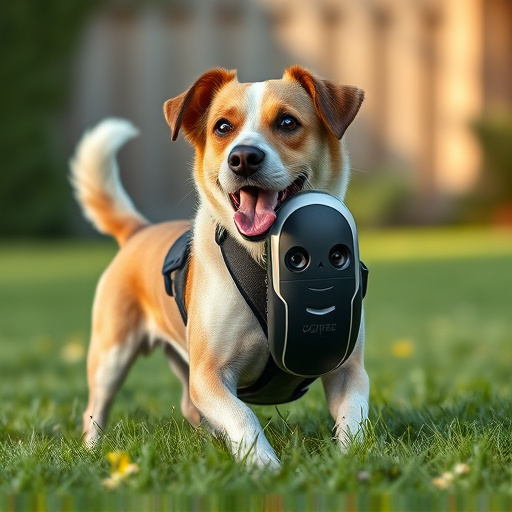Managing dog barking requires understanding its triggers and choosing ultrasonic control devices tailored to breed, with focus on range, sensitivity, safety features, and consistency in training methods, including positive reinforcement, for effective, humane behavior modification. (Ultrasonic Bark Control Device Comparison)
Dog barking can be a significant nuisance, but understanding your canine companion’s behavior is key to effective prevention. This article explores an innovative solution: Ultrasonic Bark Control Devices. We delve into the science behind dog barking, dissect various types of ultrasonic systems, and provide a comprehensive comparison of their effectiveness and safety. Additionally, we offer practical training strategies to ensure successful implementation of these devices, helping you create a quieter, more harmonious environment.
- Understanding Dog Barking Behavior and Needs
- Types of Ultrasonic Bark Control Devices
- Device Effectiveness and Safety Comparisons
- Training and Implementation Strategies for Success
Understanding Dog Barking Behavior and Needs
Dog barking is a complex behavior that can stem from various needs, including communication, territorial protection, or simply attention-seeking. Understanding these behaviors is crucial when considering electronic solutions for prevention. One popular approach is the use of ultrasonic bark control devices, which emit high-frequency sound waves that are inaudible to humans but irritating to dogs.
When comparing different ultrasonic bark control devices, it’s essential to consider factors like range, sensitivity levels, and safety features. Some devices may be more suitable for smaller breeds or specific scenarios, while others cater to larger dogs. Understanding the dog’s unique barking triggers is also key to successful implementation. By addressing these needs and utilizing the right tools, owners can effectively manage barking without causing harm or stress to their pets.
Types of Ultrasonic Bark Control Devices
Ultrasonic Bark Control Devices come in various types, each with its unique design and operational mechanism. The first type uses high-frequency sound waves that are inaudible to humans but irritating to dogs. This method is non-invasive and safe for pets as it only aims to disrupt their barking by creating an unpleasant sensation. Another variant employs a spray mechanism, releasing a mild mist when a dog barks, often combined with an ultrasonic tone for added effect.
A more advanced type integrates both audio and vibration stimuli. It emits ultrasonic sounds while simultaneously activating a gentle vibration, making it more effective in addressing persistent barking. These devices are designed to be pet-friendly, training dogs to stop barking by associating the behavior with an unpleasant but harmless experience. When compared in terms of Ultrasonic Bark Control Device Comparison, each type has its strengths and weaknesses, offering different levels of effectiveness and user convenience.
Device Effectiveness and Safety Comparisons
When comparing ultrasonic bark control devices, understanding their effectiveness is key. These innovative tools emit high-frequency sound waves that are inaudible to humans but can deter dogs from barking excessively. However, not all devices perform equally. A thorough Ultrasonic Bark Control Device Comparison reveals varying levels of success depending on factors like frequency range, sensitivity settings, and the specific behavior patterns of individual dogs.
Safety is another critical consideration. Reputable manufacturers prioritize animal welfare, ensuring their products are safe for use without causing physical harm or lasting discomfort to pets. Look for devices that include safety features such as automatic shutdown mechanisms when no barking is detected, ensuring responsible and humane usage. This comparison process empowers dog owners to make informed decisions about the best solution for managing unwanted barking while prioritizing their pet’s well-being.
Training and Implementation Strategies for Success
Training and implementing an effective dog barking prevention electronic system requires a strategic approach. One crucial method is to introduce an ultrasonic bark control device as part of your training regime. This device emits a high-frequency sound that is inaudible to humans but disrupts a dog’s ability to bark excessively. It should be used in conjunction with positive reinforcement techniques, where dogs are rewarded for quiet behavior instead of being punished for barking.
When comparing different ultrasonic bark control devices, consider factors such as range, intensity adjustment, and consistency of the sound output. Training sessions should be regular, short bursts, focusing on specific behaviors. Start by teaching your dog simple commands like “quiet” or “shh,” and gradually increase the complexity as they learn to respond to the ultrasonic prompt. Consistency is key; ensure all family members use the same commands and follow a structured training schedule for optimal results.
When it comes to addressing excessive dog barking, an Ultrasonic Bark Control Device can be a game-changer. By understanding your dog’s behavior and choosing the right device from various options available in the market, you can effectively train them without causing harm. These devices offer a humane alternative to traditional methods, ensuring peace and harmony for both pets and their owners. Through careful selection and consistent training, you can successfully prevent barking issues and create a quieter, more peaceful environment for everyone. This Ultrasonic Bark Control Device comparison highlights the importance of finding the right tool for your furry companion’s unique needs.
